The Toshiba OCZ RD400 (256GB, 512GB, 1TB) M.2 PCIe SSD Review
by Billy Tallis on May 25, 2016 8:02 AM ESTSequential Read Performance
The sequential read test requests 128kB blocks and tests queue depths ranging from 1 to 32. The queue depth is doubled every three minutes, for a total test duration of 18 minutes. The test spans the entire drive, and the drive is filled before the test begins. The primary score we report is an average of performances at queue depths 1, 2 and 4, as client usage typically consists mostly of low queue depth operations.
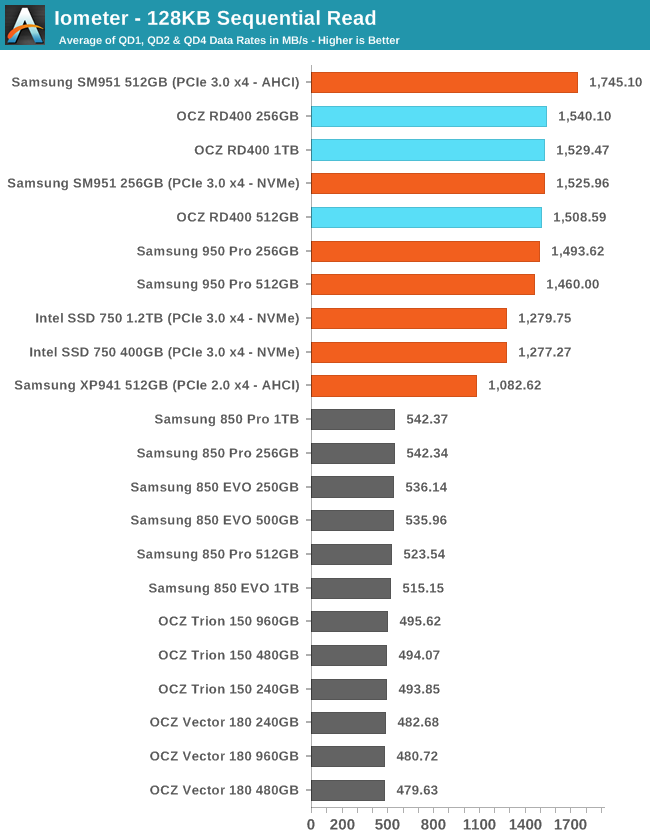
The RD400 delivers sequential read speeds on par with other PCIe 3 drives and almost three times the speed possible from a SATA drive.

The RD400 draws slightly more power than the Samsung 950 Pro. The higher performance of the PCIe drives makes them much more efficient than any of the SATA drives.
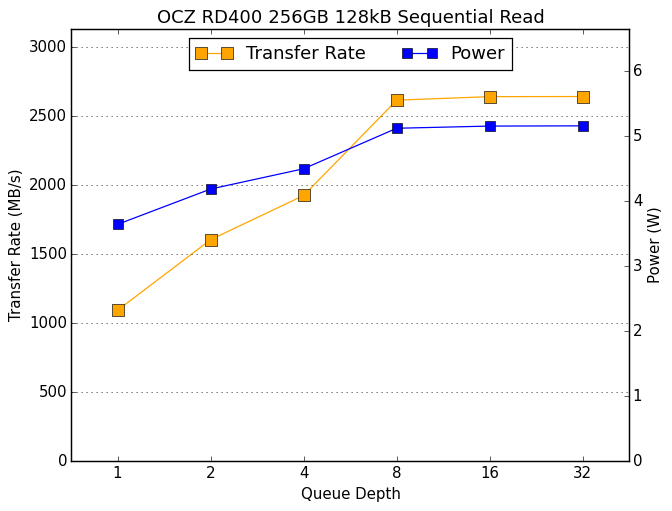 |
|||||||||
The 256GB RD400 jumps in performance between QD 4 and QD 8 where it tops out at the advertised speed, while the larger models show more modest increases during the second half of this test.
Sequential Write Performance
The sequential write test writes 128kB blocks and tests queue depths ranging from 1 to 32. The queue depth is doubled every three minutes, for a total test duration of 18 minutes. The test spans the entire drive, and the drive is filled before the test begins. The primary score we report is an average of performances at queue depths 1, 2 and 4, as client usage typically consists mostly of low queue depth operations.
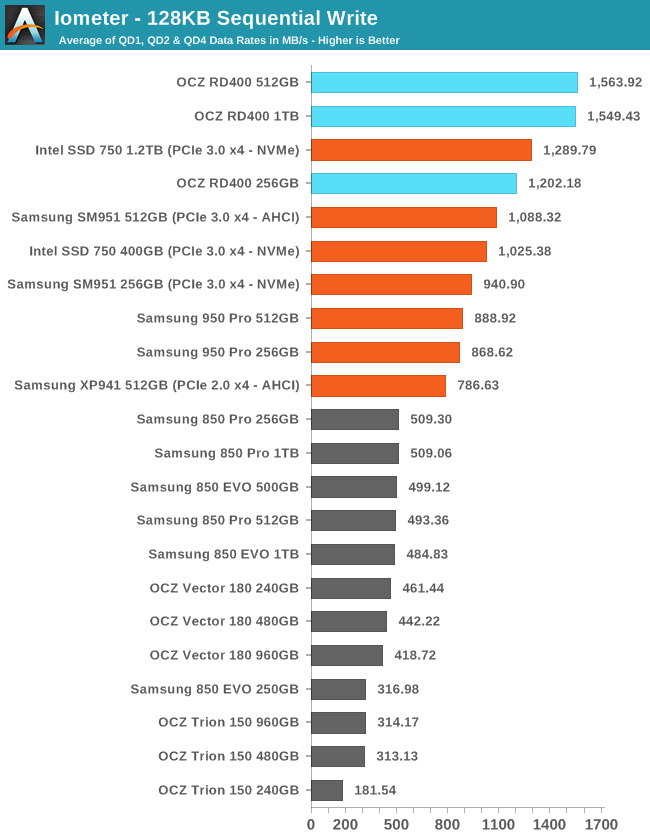
The RD400 tops the charts for sequential write speed with a substantial advantage over both Intel and Samsung PCIe SSDs.
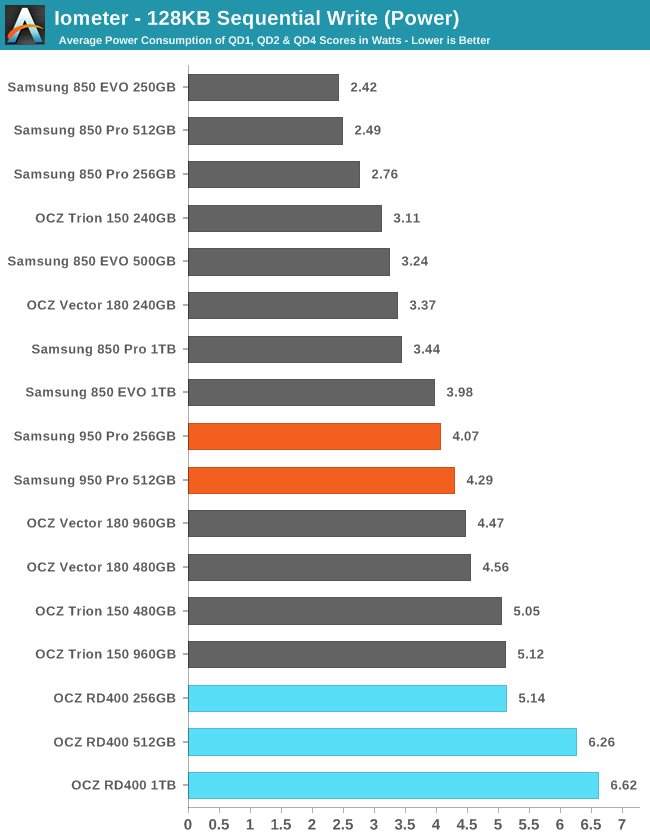
Unsurprisingly, the high performance comes with high power consumption as the 512GB and 1TB models both draw over 6W.
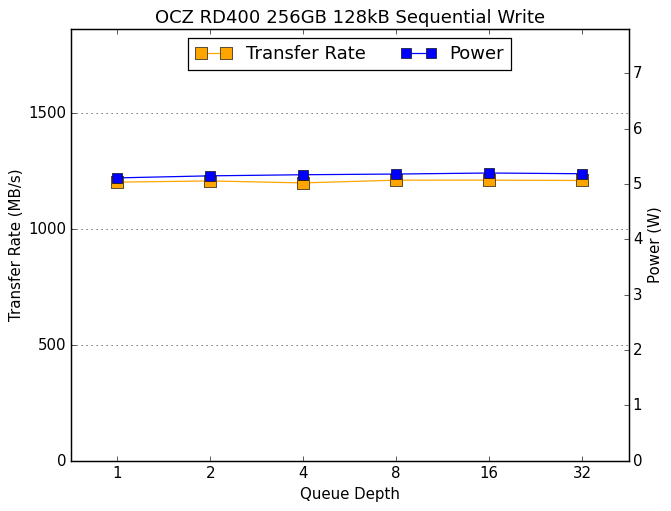 |
|||||||||
The 256GB RD400 shows constant performance across queue depths while the larger models show a slight increase from QD1 to QD2. The 1TB model wavers later in the test as thermal throttling occasionally kicks in, but even so it stays much faster overall than any competitor.










40 Comments
View All Comments
Meteor2 - Thursday, May 26, 2016 - link
So are we saying NVMe is only really useful for enterprise applications? There just aren't consumer use cases where drive speed is now the limiting performance factor?stux - Thursday, May 26, 2016 - link
This might be the case in Windows, but I've found with OSX, one of the biggest upgrades has been sata3 to PCIe ssd gen 1 to 2 and then 3Ien 0.5 to 1 to 2GB/s
This was evident with all the recent MacBook Pro 15" upgrades and also with PCIe ssds in some Mac Pro towers.
SunnyNW - Wednesday, May 25, 2016 - link
Is the flash controller made on the same memory process or is it made on a separate logic process? I think its made on a separate (logic) process and if so would that be 28nm for most controllers? And is the manufacturing out sourced to TSMC or in-house for most?Ryan Smith - Wednesday, May 25, 2016 - link
Controllers are made on a separate logic process.Kristian Vättö - Thursday, May 26, 2016 - link
The PCIe NVMe controllers are mostly 28nm from what I've heard. SATA controllers can be anything from 40nm to +55nm. Like nearly all logic manufacturing, it's outsourced to TSMC and the like.BangkokTech - Friday, May 27, 2016 - link
Recently got the SM950 pro 512. Large writes slow down after 30 seconds. It starts out ETA 3 minutes, 10 minutes later it's only 70% complete. I read into it; evidently these M.2 cards heat up and slow down. There is absolutely no heatsink on the card. Running them on a PCI expansion card would allow headspace for small heatsinks.BangkokTech - Friday, May 27, 2016 - link
Are any of you aware of a ribbon cable/riser cable I could use to get this M.2 card off my motherboard and move it to a cooler part of my case? I'm out of PCI slots for these expansion cards.Billy Tallis - Saturday, May 28, 2016 - link
Even with the degree of thermal throttling I've observed when not using any kind of heatsink, the 512GB Samsung 950 Pro should only take ~12-13 minutes to fill to capacity with sequential writes. I suspect that your bottleneck is whatever is the source of the data being written, not the 950 Pro.BiTesterEmailer - Wednesday, July 20, 2016 - link
Informative and detailed as always.